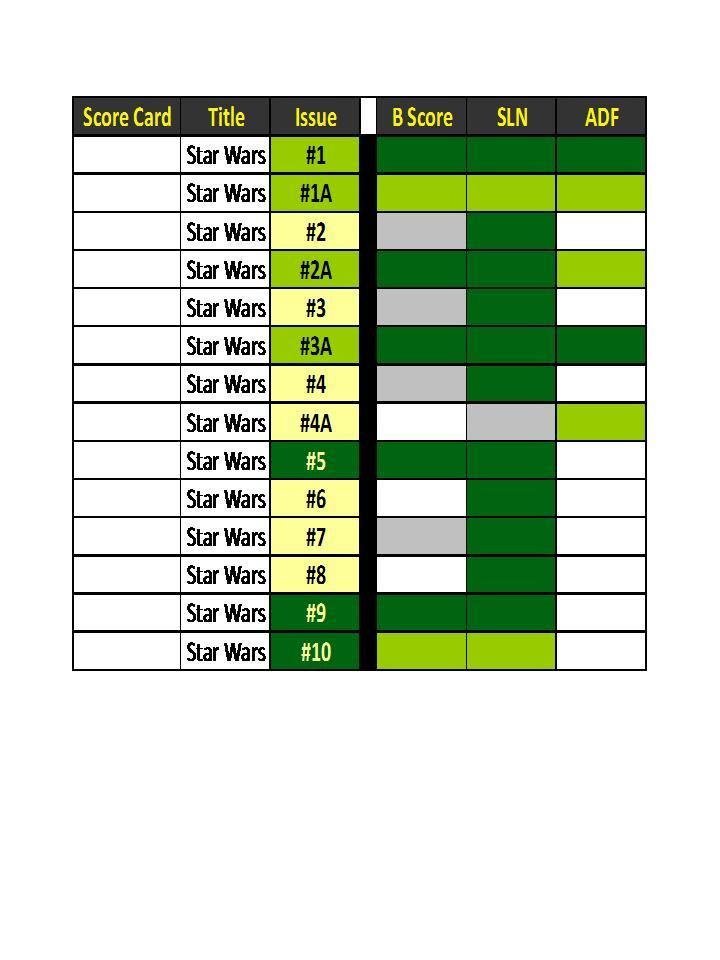Investment Potential and Analysis of Star Wars 1-10, 1A, 2A, 3A and 4A
Investment Potential and Analysis of Star Wars 1-10, 1A, 2A, 3A and 4A
The first Table
presents the Bias Score for all the issues. Bias scores show
which issues are being bought by the Insiders (Pros) vs. the Outsiders (Fans
Less Serious). The concept of my approach is to focus on the issues being
bought BULLISHLY by the investors.
We developed an
analysis of data to quantify this Bias (B Score). We mark the
issues with the highest Bias with Lime Green followed by a Dark Green staining
for issues with a lesser but definite Bias.
The Star Wars early issues are overshadowed by the 35 cent variations as those issues are denoted by the A symbol.
The Star Wars #1 35 cent variant has been one of the most valuable and sought after comic books of the Bronze Age for several years.
These were in very limited distribution, and although the exact numbers aren’t known, the estimate is about 1500 copies for issue 1.
So the B Scores are phemonal for the A issues here. B Scores of 8027, 652, 2221, for the first 3 issues with the A variant. Note Issue 4 A has a negative B Score.
The Star Wars early issues are overshadowed by the 35 cent variations as those issues are denoted by the A symbol.
The Star Wars #1 35 cent variant has been one of the most valuable and sought after comic books of the Bronze Age for several years.
These were in very limited distribution, and although the exact numbers aren’t known, the estimate is about 1500 copies for issue 1.
So the B Scores are phemonal for the A issues here. B Scores of 8027, 652, 2221, for the first 3 issues with the A variant. Note Issue 4 A has a negative B Score.
Table 2 data
deals with another data stream on comic-book issues. This run’s issues are
looked at 3 grades 9.4, 8 and 6. The changes in bias between the different
grades are calculated and the SLN
numbers were born. The SLN numbers
look into each “world” of the I vs.
O bias data. This data has shown historically
to be the most liberal and establishes the investment potential across the
grades of 9.4, 8 and 6. Very quickly, the green stained are positive issues and
red stained issues are a negative and invite a non-focus in only investments
We then compare
those SLN numbers and generate a
difference number we call the DF. Finally add the I and O SLN
numbers together (total) and determine the %DF number for each issue. Green
staining is good (Higher Bias) and Grey and Red are issues that are not good
for an investment focus. This data stream is more liberal in the rigor and you
get the best case for an issue,
Almost all issues are highlighted here except for 4A?
Table 2. SLN, DF and %DF of Star Wars 1-10, 1A, 2A, 3A and 4A

The deepest level
of analysis we developed is the ADF number (average
difference between the I/O worlds) of each issue at each grade. I denote a high
I Bias with the orange $.
Lime green
stained issues are rated I Biased in all grades or at least 9.4 and 8. Dark
green stained issues are only biased at the 9.4 grade while the other grades
are overbought relative to the professional investor’s desires.
Table 3 is the
stricter data stream and highlights both the issue and grade. We calculate the
average difference (ADF) in Issue Bias between the Insider and Outsiders
groups. Lime Green are issues that are I Biased at least 9.4 and 8 grades
(High Bias). (Orange $). The dark green issues are support with a Bias in 9.4
grade only. The other issues are to be avoided.
The Issue is that the regular number 1 is worthy of investment focus at the 9.4 grade only. The variations of 1,2,3, and even 4A are worthy of your focus as well. 4A is certainly a surprising issue based on the mixed signals!.
Table 3 ADF at Grade 9.4, 8 and 6 of Star Wars 1-10, 1A, 2A, 3A and 4A

Table 4 is the
Score Card information for each issue at the 3 data streams. This allows a top
down view across the data streams. We denote the issues supported in all three
data streams with a Lime Green staining. Dark Green has only 2 data streams
support and yellow issues are supported in one data stream only.
So as before its 1, 1A, 2A, and 3A. That is it.
Table 4 Score Card Analysis of Star Wars 1-10, 1A, 2A, 3A and 4A

Table 5 is the
last bit of data, the Scaled
Desire Ranking. I have grouped 1356 issues of comics that I have covered
and developed scaled desire rankings. The percentile that an issue occupies
gets wonderful insight into true value between titles. So we position our title
and its key issues in context. A score
of 99 means that comic issue is desired at the highest level while 1 percentile
is the lowest desired issue.
Amazing desire rankings!. 1,2,3A in the 93 percentile vs top comics like FF, Avengers, Early ASM etc!
So given the price of the early marvels, I am think these are worth the expense investment. My data suggest room to go up!. Given the new movie another generation will be focused on Star Wars when they are in their 30/40s and can invest in their childhoods. So in 2030-40 is the sell time-frame if you mortgage you house to get one. I would have to will it to my children for their college fund then!
Table 5 Scaled Ranks for Star Wars 1-10, 1A, 2A, 3A and 4A



Comments
Post a Comment